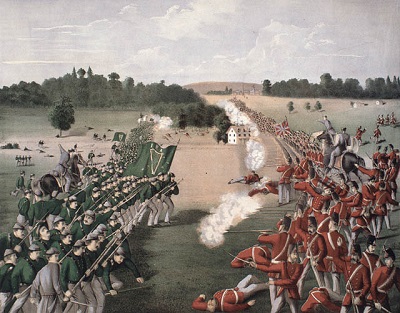Ridgeway Battlefield National Historic Site of Canada
Ridgeway, Ontario

Depiction of the battle of Ridgeway
(© Library and Archives Canada | Bibliothèque et Archives Canada, Acc. No. 1946-35-1)
Address :
3408 Garrison Road, Ridgeway, Ontario
Recognition Statute:
Historic Sites and Monuments Act (R.S.C., 1985, c. H-4)
Designation Date:
1921-05-21
Dates:
-
1866 to 1866
(Significant)
Event, Person, Organization:
-
Lieutenant Colonel Alfred Booker
(Person)
-
Colonel John O'Neill
(Person)
-
Canadian Volunteer Militia
(Organization)
-
Fenian Brotherhood
(Organization)
-
The Queen's Own Rifles
(Organization)
-
13th Hamilton Battalion
(Organization)
-
Caledonia Rifle Company
(Organization)
-
York Rifle Company
(Organization)
Other Name(s):
-
Ridgeway Battlefield
(Designation Name)
-
Battle of Ridgeway
(Other Name)
-
Lime Ridge
(Other Name)
-
Battle of Ridgeway
(Plaque name)
Research Report Number:
2008-CED/SDC-22
DFRP Number:
56532 00
Plaque(s)
Approved Inscription: 3408 Garrison Road, Ridgeway, Ontario
On 2 June 1866, Canadian militia volunteers including the Queen’s Own Rifles and the 13th Battalion fought here against the Fenian Brotherhood. Based in the United States, the Fenians were Irish nationalists dedicated to freeing Ireland from British rule in part by taking British North America hostage. They won the Battle of Ridgeway, but with their reinforcements cut off and Canadian, British, and First Nations reinforcements mobilizing, they retreated across the border. Fenian raids continued across Canada until 1871, leading to a larger militia, a stronger sense of patriotism, and greater support for Confederation.
Description of Historic Place
Ridgeway Battlefield National Historic Site of Canada is located within a four-hectare parcel of parkland in the small community of Ridgeway in southwestern Ontario, approximately five kilometres west of the Town of Fort Erie. The site consists of the 1866 battlefield, which now includes privately owned rural agricultural properties. There are no known in situ remains of the battle. Official recognition refers to the approximate limits of the 1866 battlefield.
Heritage Value
Ridgeway Battlefield was designated a national historic site of Canada in 1921. It is designated because: the Queen’s Own Rifles, 13th Hamilton Battalion, Caledonia and York Rifle Companies of Haldimand fought here, in defence of their country, against Fenian raiders, on 22 June 1866.
The Battle of Ridgeway was fought between the Canadian Volunteer Militia and about 500 to 800 Fenian invaders on 2 June 1866, just north of what was then the town of Ridgeway. Skirmishing began between the Militia and the Fenians near the intersection of Ridge Road and Garrison Road, but most of the fighting occurred on or near Lime Ridge, an elevated terrain that ran almost parallel to Ridge Road. The Canadian Volunteer Militia, led by Lieutenant Colonel Alfred Booker initially made a strong stance against the Fenian invaders led by Colonel John O’Neil. Although the Militia outnumbered the Fenians, they were unable to repel the invaders due to lack of experience and training, and supply issues. After a valiant stand, the Canadian Volunteer Militia was forced to retreat to the nearby village of Stevensville. The Fenian raiders returned to the United States the following day, fearful of Militia reinforcements being sent from Chippawa, near Niagara Falls.
Sources: Historic Sites and Monuments Board of Canada, Minutes, October 2008; Plaque Text, May 1929.
Character-Defining Elements
Key elements contributing to the heritage value of this site include: its location in the small community of Ridgeway, approximately five kilometres west of the Town of Fort Erie, Ontario; its setting within an open landscape near Lime Ridge, an elevated terrain that ran parallel to Ridge Road; the integrity of any surviving or as yet unidentified archaeological remains which may be found within the site in their original placement and extent; the relationship between the site and the Canada-United States border at the Niagara River; viewscapes from Lime Ridge to the intersection of Ridge Road and Bertie Road where the main battlefield was located.